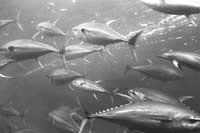Atunes as a robot construction model
To achieve as fast and precise movements as possible during the construction of robots, scientists analyze the characteristics of animal bodies. On this occasion, tuna has been an animal that researchers at the University of California in San Diego have taken as a model.

According to a study conducted using ultrasound techniques, tuna muscles are specially designed to achieve high water speed. In fact, most tuna muscles are concentrated in the center of the body, projecting muscle strength from the center to the tail. The tail, on the other hand, functions as a propeller that moves the body forward.
Other fish, however, have muscles spread throughout the body and, when contracting them, the body is scared. In tunas, as the muscles are closer to the spine and therefore further away from the skin, they contract much more and work more and produce more energy. The ripple of the central parts of the body would increase friction. These results will serve to build better marine exploration vehicles and try to better understand evolution.





